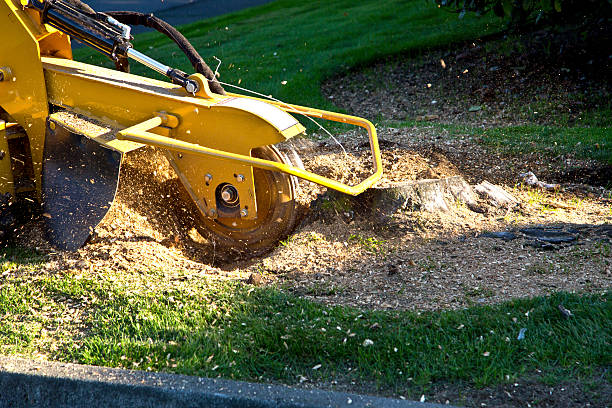Starting a stump removal project involves choosing the right method from options like stump grinding, manual digging, chemical application, or even burning, each with unique advantages and drawbacks.
Selecting the best approach requires considering factors like stump size, environmental impact, and safety.
Ensuring a smooth and safe process also means understanding local regulations and protecting nearby areas.
Let’s explore the key considerations that can help guide you through a successful stump removal.
Stump Removal Techniques
Removing a tree stump can be a challenging task, but with the right approach, it can be done efficiently and effectively.
Here are some common methods for stump removal:
Stump Grinding
- Efficiency: This method involves using a specialized machine to grind the stump into small wood chips.
- Minimal disruption: It’s a relatively quick process that leaves minimal disruption to your landscape.
- Professional equipment: Requires access to a stump grinder, often best handled by a professional.
Digging Out the Stump
- Manual labor: This method involves manually digging out the stump and its roots.
- Time-consuming: Can be a lengthy process, especially for larger stumps.
- Physical effort: Requires physical strength and effort.
Chemical Removal
- Less physical exertion: Involves applying a chemical solution to decompose the stump over time.
- Slower process: Can take several weeks or months to complete.
- Environmental considerations: Follow safety guidelines and dispose of chemicals properly.
Burning
- Quick removal: Can be a fast method for smaller stumps.
- Safety risks: Requires caution and may require permits in certain areas.
- Environmental impact: Consider the potential impact on air quality and surrounding vegetation.
Choosing the Right Method:
The best method for you will depend on factors such as the size of the stump, your budget, and your level of expertise.
For larger or more stubborn stumps, it’s often best to hire a professional tree service.
Additional Considerations:
- Root removal: Ensure that the roots are also removed to prevent regrowth.
- Soil leveling: Once the stump is removed, level the surrounding soil.
- Planting new trees or plants: Consider planting new trees or other plants in the area.
By carefully considering these factors, you can choose the most appropriate method for your specific needs and achieve a successful stump removal.
Environmental Considerations for Stump Removal
When choosing a stump removal method, it’s important to consider the environmental impact.
Here are some factors to keep in mind:
Chemical Removal:
- Potential for soil contamination: Chemicals can seep into the ground and harm plants and groundwater.
- Choose eco-friendly options: Opt for biodegradable and less toxic chemicals.
Mechanical Removal (Stump Grinding):
- Minimal environmental impact: Generally considered a more environmentally friendly option.
- Potential for noise and air pollution: Consider the type of equipment used and the proximity to neighbors.
Natural Decomposition:
- Eco-friendly: A natural process that doesn’t involve chemicals or machinery.
- Slow process: Can take several years to complete.
Additional Considerations:
- Soil erosion: Consider planting grass or other vegetation to prevent soil erosion.
- Wildlife habitat: Avoid disturbing the local ecosystem.
- Local regulations: Check local regulations for any restrictions or permits required for stump removal.
By carefully considering these factors, you can choose a stump removal method that minimizes environmental impact and promotes sustainable practices.
Tips for Successful Stump Removal
Here are some tips to help you successfully remove a tree stump:
Assess the Stump:
- Size and condition: Determine the size and condition of the stump to choose the appropriate removal method.
- Root system: Consider the extent of the root system, as this will impact the difficulty of removal.
Prepare the Area:
- Clear the area: Remove any debris or obstacles around the stump.
- Safety gear: Wear protective gear, including gloves and goggles.
Choose a Removal Method:
- Stump grinding: A quick and efficient method for most stumps.
- Digging: A manual method that can be time-consuming for larger stumps.
- Chemical removal: A slower method that involves applying chemicals to decompose the stump.
- Burning: Not recommended due to safety concerns and potential environmental impact.
Follow Safety Guidelines:
- Professional help: Consider hiring a professional tree service for large or complex stump removals.
- Equipment safety: Use proper equipment and follow safety instructions.
- Chemical safety: Wear protective gear and follow the manufacturer’s instructions when using chemical treatments.
By following these tips and choosing the right method, you can successfully remove a tree stump and restore your outdoor space.
With the right preparation and method, stump removal can be a straightforward process that enhances your landscape and restores usable space.
By considering factors like the environmental impact, local regulations, and the specific needs of your site, you can choose a removal approach that’s both safe and effective.
Taking these steps ensures that your outdoor area is ready for fresh landscaping or new plantings, helping you make the most of your space in a way that’s sustainable and visually appealing.

